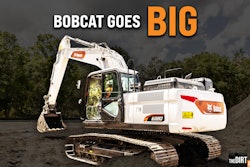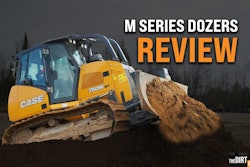Dozers and other equipment get the spotlight when it comes to moving dirt, but the humble pull-type scraper can be a more efficient, productive machine for mass earthmoving.
On this episode of The Dirt, we delve into John Deere’s new 3012 and 3812 four-tire ejector scrapers with Matt Costello, product marketing manager.
The scrapers have 30- to 38-cubic-yard capacities and 12-foot-wide bowls. (The first number in the model signifies its heaped capacity in cubic yards, while the “12” represents its bowl width in feet.) The direct-hitch models attach to high-horsepower tractors. Deere also offers a gooseneck version of its 3812 that can connect to a converted Deere 460 P-Tier articulated dump truck.
The 3812 marks the largest direct-hitch scraper in Deere’s lineup.
Costello explains some of the differences between pull-type and self-propelled scrapers, what kinds of conditions are best for scrapers and the best carrier machines for pull-type models.
So if you want to learn more about Deere’s new scrapers or are just curious about these mass-earthmoving machines, be sure to check out the latest episode of The Dirt.
Tap into the power of Fusable's vast industry intelligence – over 100 million entities, activities, and transactions – to identify and capitalize on new growth opportunities for your business. Explore at Fusable.com/TheDirt. (Fusable is the parent company of Equipment World and the sponsor of The Dirt.)
In This Episode:
- 00:00 – Deere’s New Scrapers
- 00:33 – Self-Propelled or Pull-Behind?
- 00:52 – Industry Shift to Pull-Behind Scrapers
- 01:37 – Size and Specs of Deere’s New Scrapers
- 02:38 – Can Any Tractor Pull These?
- 03:51 – John Deere Scraper Portfolio
- 04:09 – Can a Scraper be Pulled by a Tractor or an ADT?
- 04:41 – Best Soil Types for Scrapers
- 05:48 – Machine Control Integrations
- 07:15 – Final Thoughts
00:00:00:04 - 00:00:25:03
Bryan Furnace
Get reimbursed faster for extra work with Equipment Watch's Rental Rate Blue Book. Learn more at fusable.com/thedirt.
Hi everybody. Welcome back to Equipment World. You're watching The Dirt. I'm your host, Bryan. And today we're here to talk about the biggest, most efficient dirt movers in the industry. We're here to talk about scrapers. And today, specifically, we're here to talk about John Deere scrapers and some of the new products they're adding to their lineup.
00:00:25:05 - 00:00:32:04
Bryan Furnace
So without further ado, here's Matt with John Deere.
00:00:32:06 - 00:00:41:03
Bryan Furnace
So my first question is just a stupid high-level question about these things. Are we talking self-propelled scraper units or are we talking pull behind units?
00:00:41:05 - 00:00:52:05
Matt Costello
Yeah. So for those scrapers we're reviewing today on our new large pans, they're all pulled behind units. Two of them are pulled behind our tractor systems, and one of them is pulled behind the converted ADT.
00:00:52:07 - 00:01:16:16
Bryan Furnace
So I've noticed through the years, you know, it used to be all you saw on job sites were self-propelled units. And then there was this I would argue it's a relatively short transition period where you would see fleets of mixed, but largely now what I see in my neck of the woods are pull behind units. Do you have any insight as to why the industry is starting to trend towards these pull behind units?
00:01:16:18 - 00:01:35:21
Matt Costello
Yeah, I think the pull behind units offer some simplicity for an operator, especially when you're looking at the larger single pans over maybe the multiple paying opportunities that we have. So maneuverability on the job site, reducing shipping costs, training the operators, helping them get up to speed, be productive and move as much period as they can.
00:01:35:21 - 00:01:44:11
Bryan Furnace
Gotcha. What are the size of the units that we're talking that you guys are introducing? I have no feel for what how big these things are and what the capacities are.
00:01:44:13 - 00:02:12:08
Matt Costello
Yeah. So our our previous large largest scraper we had was a 2412. And those could be pulled in up to groups of three. And now we're offering a 3812 and a 3012 direct hitch or tractor pull behind. And that what that means is it's 38 cubic yard capacity and 12ft wide. And then we also have a 38 cubic yard, 12ft wide or 38, 12 articulated or gooseneck scraper that we can pull up behind that converted truck.
00:02:12:10 - 00:02:16:07
Bryan Furnace
And are these units still able to be pulled in sets of three?
00:02:16:09 - 00:02:37:21
Matt Costello
These units here are all just one single pan that you'll be pulling just because of the capacity of them. For instance. Okay, the 3812 direct hitch is only going to be tied to our new nine high horsepower offerings, but then the 3012 direct hitch can be pulled behind any of the nine. Our tractor offerings that that we have available.
00:02:37:23 - 00:02:56:04
Bryan Furnace
Okay. And just to clarify, there, as a business owner, does the new model, I'm assuming it's any high horsepower tractor that can pull these units. Or are there things integrated into it that it needs to be a John Deere tractor? But before we get into that, I want to take a second to tell you about the sponsor of this video.
00:02:56:06 - 00:03:19:17
Bryan Furnace
Tired of guessing when it comes to your equipment costs are underutilized machines eating into your profits? We know it's a common challenge in construction. That's where Equipment Watch by Fusable comes in. They're the industry leading source for accurate equipment values, true ownership costs, and crucial utilization data. Imagine having the real numbers at your fingertips to make informed decisions that directly impact your bottom line with equipment.
00:03:19:17 - 00:03:41:22
Bryan Furnace
With Equipment Watch, you can see the full picture. Optimize your fleet and bit with real confidence. Take control of your equipment expenses and gain a real competitive edge. Visit fusable.com/thedirt to learn how equipment watch can help you. I'm assuming it's any high horsepower tractor that can pull these units. Or are there things integrated into it that it needs to be a John Deere tractor?
00:03:42:00 - 00:03:45:10
Matt Costello
Yeah. So high horsepower tractor would be the requirement there.
00:03:45:14 - 00:03:45:21
Bryan Furnace
Okay.
00:03:46:03 - 00:04:09:11
Matt Costello
For those we do have the ability to adapt those to different offerings. One of the advantages we do have within the scraper business is we do offer one of the largest scraper portfolios, as well as owning the opportunity for the power system as well with the tractor. So one stop shop for that customer and dealer experience when you're, you know, servicing or purchasing that equipment.
00:04:09:17 - 00:04:25:04
Bryan Furnace
So you mentioned that there's kind of a gooseneck model and there's a direct couple model for a tractor. Are these units able to be converted from one pulling unit to another. Or is it we go by a pan and it's going to be dedicated towards an ADT. And we're going to buy this pan and it's dedicated towards a tractor pull.
00:04:25:08 - 00:04:39:19
Matt Costello
Yeah. So it's, it's going to be dedicated to the hitch style that it's purchase says there are a lot of components like cutting edges and service parts that are compatible between the two. But once a gooseneck, it'll stay as a gooseneck and direct hitch to direct hitch.
00:04:39:21 - 00:05:07:04
Bryan Furnace
Gotcha. So for someone who might have not ever dabbled in the scraper market whatsoever, but they're kind of looking at these and and acknowledging how efficient these units are moving material around the jobsite for that customer, what kind of soil conditions do these units really perform well in, and where do they really excel? Is it going to be able to do well in really rocky soil, or are these really geared more towards softer soils?
00:05:07:04 - 00:05:08:03
Bryan Furnace
What are we looking at?
00:05:08:03 - 00:05:24:18
Matt Costello
Yeah, the softer soils are your clays are going to be better for, you know, cutting and rolling that material, filling that pan up as much as you possibly can. But again, you're not going to run into some of those obstacles as you're shaping that. And then a lot of the determining factors for a scraper is also your haul distance.
00:05:24:18 - 00:05:47:11
Matt Costello
So how far are you hauling this material? Are we top loading. Are we doing general scraper scraping. All of these large pans if needed. Also have the the backside of it is set up to be able to be push loaded. So if you're in that thicker, stickier, wetter condition, we can put a dozer back there and help push load that machine to kind of get it through that cut and get it filling up as effectively as possible.
00:05:47:13 - 00:06:00:12
Bryan Furnace
So my final question for you is, are these able to integrate with any sort of machine control. And I want to break that kind of into two parts. The machine control if it can integrate is that indicate only or do you get some automatic integration as well.
00:06:00:12 - 00:06:29:05
Matt Costello
So right now on our large pans there's no automatic integration. I know there's a few things in the field that can be done, with some of the things through different dealer networks and whatnot. But we do offer some different technologies within our scrapers, and one of the ones that we're happy to have now with our ADT fold scraper is the Scraper Pro system, which does automate a lot of the common functionality of cutting, unloading, loading, hauling empty where it's just a simple press of a button.
00:06:29:05 - 00:06:57:15
Matt Costello
So we're we're simplifying it even more for that. Operator. That's especially newer to that operation where they can press that button. The pan is going to do what it needs to do to cycle for that operation, and they can move on. And there's a really nice display in there as well that is going to help you kind of show the position of that, the bowl and the cutting edge, as well as a camera that actually faces back at that cutting edge so that you can see your material being loaded and and when you maybe need to exit or enter that cut as well.
00:06:57:20 - 00:07:14:10
Bryan Furnace
Excellent. That sounds like an awesome feature for I know a lot of the scraper fleets that I'm familiar with. They generally put some of their newer operators in there that don't necessarily have the skills to really run it efficiently right away, so having those sort of options available seems like it'd be a really great tool for a business owner.
00:07:14:12 - 00:07:20:10
Bryan Furnace
Well, Matt, thank you again for being on the show. I really appreciate all the information on this. I'm excited to see one of these in action in the field.
00:07:20:12 - 00:07:24:16
Matt Costello
Yeah, I really appreciate the time and always look forward to talking about John Deere equipment.
00:07:24:18 - 00:07:39:00
Bryan Furnace
Well, thank you again for Matt coming on the show to discuss scrapers with us. These are some of the coolest machines in the industry. It is always a lot of fun to watch a big pan in action. So as always, I hope this helps you and your business and gives you a little more information to be more efficient yourself.
00:07:39:02 - 00:07:40:18
Bryan Furnace
We'll catch you on the next episode of The Dirt.










